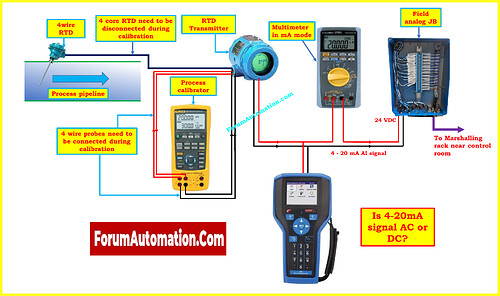Is 4-20mA signal AC or DC?
Is a 4-20mA Signal AC or DC?
The 4-20mA signal is an analog signal that uses direct current (DC), not alternating current (AC). This standard is frequently used in industrial equipment to send analog signals from field instruments like temperature, pressure, or level transmitters to control systems like PLCs or DCS.
Why DC?
The 4-20mA loop works with a steady flow of current in one direction. It is usually driven by a DC voltage source between 12V and 32V, with 24VDC being the most popular. There is no alternating waveform or polarity reversal in the signal because it is carried on a steady DC current.
Purpose of 4-20mA Signal
- 4mA is the live zero, which lets you find wiring problems like an open loop (0mA).
- 20mA is the highest level, like the highest temperature or pressure.
- This current loop doesn’t pick up noise over lengthy wire runs, which is a big plus in industrial settings where there is a lot of electromagnetic interference.
Current Loop Working
The transmitter changes the current in the loop based on the variable that is being monitored. The device that gets this current, like a control system or a multimeter in mA mode, uses it to figure out what the physical measurement is. When devices are in the loop, they are connected in a series, which makes sure that the same current goes through all of them.
Industrial instruments employ a 4-20mA signal, which is a DC (Direct Current) signal, not an AC (Alternating Current) signal. This standard is often used to send analog signals from field equipment (such RTD transmitters) to control systems through analog input (AI) modules, as seen in the picture.
A 4-wire RTD in the picture measures the temperature in the process pipeline. An RTD transmitter gets the signal and changes the resistance signal into a 4-20mA current output. This 24VDC-powered analog signal goes through a field analog junction box (JB) and is sent to the marshalling rack near the control room. The power supply is clearly marked as DC (24VDC), which means that the current loop works on DC voltage.
For calibration and verification of the signal, a process calibrator and a multimeter set to mA mode are utilized. The multimeter shows the real loop current, and the calibrator may mimic sensor results by sending exact resistance or current signals. Also shown is a Hart communicator that may be used to set up or read transmitter parameters over the same loop. This is another way to make sure the signal is stable and DC-based.
The current in a 4-20mA loop flows in one direction and stays the same, unlike AC, which changes in a sinusoidal pattern. The 4mA (live zero) signal lets you find faults, and the 20mA signal shows the whole range of measurement. The loop is the industry standard for sending analog signals because it employs DC, which makes it less likely to pick up noise, allows for long-distance transmission, and is easy to wire.
The 4-20mA signal is a DC signal, which makes it great for process automation because it can communicate clearly and without noise.
A 4-20mA signal is DC, which means it is simple, reliable, and not affected by voltage drops or signal noise. This makes it perfect for sending analog signals in industrial process automation.
